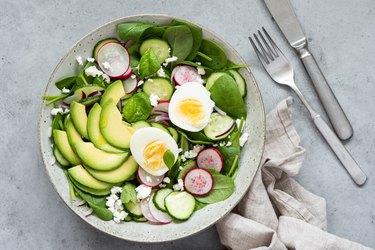
If you've been thinking about changing your diet, you may have heard a lot about sodium. This chemical element occurs naturally throughout nature. Even healthy foods like fruits and vegetables are natural sources of sodium, although their levels don't compare to those found in processed foods.
Tip
Sodium occurs naturally in almost every food — but the sodium content in fruits, vegetables and whole grains is much lower than you'll find in highly processed foods.
Video of the Day
Why Sodium Matters for You
Sodium isn't all bad. In fact, as explained by the U.S. National Library of Medicine, you need a certain amount of sodium in your body for your muscles and nerves to work; your body uses sodium to control its blood pressure, blood volume and overall fluid balance.
Video of the Day
But if you get too much sodium in your diet — which includes not just the foods you eat, but also everything you drink — it can cause serious health problems, including high blood pressure, heart disease, stroke and calcium loss, as noted by the Harvard T.H. Chan School of Public Health. They also observe that the typical American consumes about 1.5 teaspoons, or 3,400 milligrams, of salt per day — far more than the 1,500 milligrams that's considered the daily adequate intake for adults.
The 2015-2020 Dietary Guidelines for Americans are a little more liberal, recommending that adults limit their daily sodium intake to no more than 2,300 milligrams. Your doctor might recommend either of those levels to you, depending on your current diet and health history.
As you consider which foods high in sodium are in your diet, remember this: Although the list of foods that contain salt naturally is incredibly long, Harvard Health Publishing notes that almost two-thirds of the typical American's daily sodium intake comes from food purchased in stores, with another one-quarter coming from restaurant food.
Some of the biggest contributors include bread and rolls, cured meats, pizza, poultry, soup, burgers and other sandwiches. One of the best ways to dodge those hidden sources of sodium is by preparing your own food at home — that way, you have ultimate control over what ends up on your plate.
Read more: 10 Effortless Ways to Finally Cut Down on Salt
Foods That Contain Salt Naturally
What about sources of natural sodium? Foods like fruits, vegetables, whole grains and nuts almost always have some sodium, but it's incredibly low when compared to processed foods. Consider these examples of sodium content per serving from the Linus Pauling Institute:
- 1 cup frozen orange juice: 0 mg
- 1/4 cup unsalted almonds: 0.3 mg
- 1 medium pear: 2 mg
- 1 mango: 4 mg
- 1 medium tomato: 6 mg
- 1 cup cooked brown rice: 10 mg
- 1 medium carrot: 42 mg
Compare that to the same institute's list of the sodium content in highly processed foods, and you'll see a marked difference:
- 1 cup bran flakes: 216 mg
- 2 slices white bread: 344 mg
- 1 cup canned chicken noodle soup: 789 mg
- 2 ounces salted mini-pretzels: 1,029 mg
- 3 ounces minced ham: 1,059 mg
There are quite a few high-sodium drinks out there too. If you make a habit of checking the nutritional facts label before you put something in your cart at the grocery store, you might just be surprised by how much sodium you've been bringing home without realizing it.
If you want a proven framework for reducing your sodium intake, consider the DASH (Dietary Approaches to Stop Hypertension) diet. As the National Heart, Lung, and Blood Institute (NHLBI) explains, this diet, which particularly limits sodium and saturated fat intake, has been well-studied and shown to improve your cardiovascular health.
But even if you're not following the DASH diet, you can still use some of the NHLBI's tips to decrease your sodium intake. For example, choose fresh meats instead of cured meats, and opt for fresh or frozen fruits and vegetables over canned — if you can.
If you're in a position where you need to eat canned foods, look for low-salt or no-salt versions; often, they'll be stocked right next to the full-sodium products. The NHLBI also recommends rinsing canned foods and other brine-soaked products before you use them — that'll help remove the sodium.
- National Heart, Lung, and Blood Institute: "DASH Eating Plan"
- U.S. National Library of Medicine: "Sodium in Diet"
- Harvard T.H. Chan School of Public Health: "Salt and Sodium"
- Health.gov: "Dietary Guidelines for Americans, 2015-2020: Chapter 1. Key Elements of Healthy Eating Patterns"
- Harvard Health Publishing: "Everyday Foods Are Top 10 Sources of Sodium"
- Linus Pauling Institute: "Sodium (Chloride)"